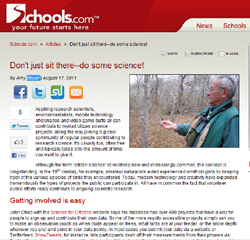 Amy Mayer at Schools.com wrote a nice story about citizen science, featuring a few insights from Science for Citizens contributors Drs. Lisa Gardiner and John Ohab.
Amy Mayer at Schools.com wrote a nice story about citizen science, featuring a few insights from Science for Citizens contributors Drs. Lisa Gardiner and John Ohab.
Here’s a quick excerpt:
Aspiring research scientists, environmentalists, mobile technology aficionados and video game buffs all can contribute to myriad citizen science projects, along the way joining a global community of regular people contributing to research science. It’s usually fun, often free and typically takes only the amount of time you want to give it.
Although the term “citizen science” is relatively new and increasingly common, the concept is longstanding. In the 19th century, for example, amateur naturalists aided experienced ornithologists by keeping track of the various species of birds they encountered. Today, modern technology and creativity have expanded tremendously the types of projects the public can participate in. All have in common the fact that volunteer public efforts really contribute to ongoing scientific research.
Getting involved is easy
John Ohab with the Science for Citizens website says his database has over 400 projects that have a way for people to sign up and contribute their own data. Some of the more readily accessible projects simply ask you to make an observation (such as when buds appear on trees, what birds are at your feeder, or the snow depth wherever you are) and send in your data points. In most cases you submit your data via a website or Twitterfeed. SnowTweets, for instance, lets participants dash off their measurements from their phones via Twitter. Cyrosphere researchers at the University of Waterloo in Canada collate the snowfall data and use it to check data from satellite observations.
Projects appeal to different people depending on their specific interests. Ohab says those that, like SnowTweet, harness the power of smartphone technology, often appeal to high school and college students.
Expanding the scientific community
One collaboration among a dozen science centers around the country is developing a smartphone app for the public to help gather data on the Urban Heat Island Effect. C3: Communicating Climate Change is a project that hopes to develop a robust database of the temperatures along the urban-rural gradient–in other words, amassing large datasets so that meaningful interpretations can be made. According to the Maryland Science Center’s website, the difference between the temperature of a metropolitan area and the rural areas that surround it, or the Urban Heat Island, “is not an effect of climate change, but rather of human activity shaping our environment. One may ask, if we can make changes on a local scale, are we also responsible for changes globally?” Citizen scientists will provide the raw data that researchers use to explore this and other questions.
Read the full story at Schools.com.
